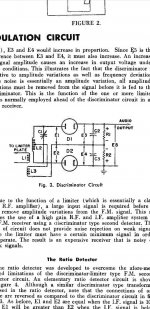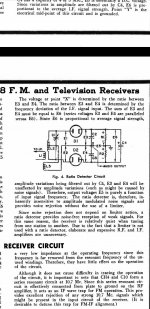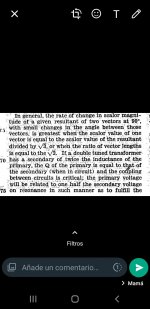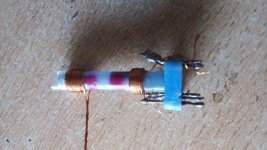I would have wound some if proper DIY coil formers were available. Some 60 years ago (in the Netherlands) transformers and chokes were constructed in a way that the same former could be reused so I rewound several transformers because (verified by measurement) the cores could handle more power. Constructing your own former was possible too, here not (no material for construction available).
You already wrote that using a coil instead of a cap is cheaper, often an indicator that it has been discovered already. When the limiter's anode voltage is low enough, the wires provide enough isolation. Your receiver has plenty of gain so the last IF stage can be used with low Va, limiting always.
The traditional stereo-decoder has a 19 K filter which can be fitted with an AM detector. It provides a noise output that after amplification can activate squelch and / or stereo. When economizing on IF gain (with ratio discriminator) that isn't an option.
The traditional stereo-decoder has a 19 K filter which can be fitted with an AM detector. It provides a noise output that after amplification can activate squelch and / or stereo. When economizing on IF gain (with ratio discriminator) that isn't an option.
Some years ago I tested the insulation of some locally manufactured enamel copper wires as this data is unavailble here. Using a variac, a insulating 220:880V trafo and a series lamp, l twisted 10cm of 0.15mm wire and give sufficient voltage until isolation was broken and the series lamp lights. This so rudimentary as simple but effective method, perhaps out of any standard, let me know that in the 1 minute period the isolation of said wire could wistand about 800VAC and 750 during an hour. The test were obviously, destructive but waste 50cm of unwound wire is by far better than a half kg wound on a toroid.
Thus, l am completelly sure that a 0.22mm will survive to 135~140VDC.
In the other hand, and as I said previously, silvered mica caps are known for shortcircuiting themselves for silver molecules migration still when used well below its WV that in my case, is also unknown. See for example https://antiqueradios.com/forums/viewtopic.php?t=88211.
Thus I strongly prefeer the tertiary coil.
Thus, l am completelly sure that a 0.22mm will survive to 135~140VDC.
In the other hand, and as I said previously, silvered mica caps are known for shortcircuiting themselves for silver molecules migration still when used well below its WV that in my case, is also unknown. See for example https://antiqueradios.com/forums/viewtopic.php?t=88211.
Thus I strongly prefeer the tertiary coil.
Good, simple and cheap test for wire isolation. The wire I have, same issue: no or insufficient data. I looked up silver migration on those capacitors and concluded that for modern silver-mica caps like on the pics you posted, it's a nonissue because migration occurs horizontally, on the same plane. In order to save space, the caps of those old transformers used 2 silver areas on the same plane. Modern caps only have silver on opposite sides of the mica so no whiskers can form between them. This site shows photos with replacement of the whisker-prone caps:
http://oldradio.ca/radio/Tech/IFmica/IFmica.html
http://oldradio.ca/radio/Tech/IFmica/IFmica.html
Yeahhhh!! I looked this page several years ago when making the AM tuner project already published here, and l had the same issue with the same K-Trans IF transformers. I solved it using 110pF mica caps outside the shielding can.
Such space saving whisker & electrophoresis prone caps I never met in European gear. Even old radios were fitted with foil caps and they too are long life. The traditional silver mica caps were used were frequency stability and low loss matters. For an eventual variable bandwidth IF processor I've got plenty, and they still are available. A modern through-hole alternative was Philips ceramic caps. Very low loss, and available in several values of temperature coefficient (50V only). I once used them in an SSB-stable 32 MHz VFO. But out of production alas.
Apart from those C's the transformers suggest a good mechanical construction. In Europe the problem was brittle ferrite slugs. With bad luck you had to buy new transformers just for the slugs. While I still have a collection of Toko and similar small coils that could be used for tube IF bandpass filters as well, my favorite solution became the use of iron powder toroids (Micrometals) with good quality caps and a trimmer cap. Thanks to the high unloaded Q you can use them in filter simulations with 100% reliability, and for construction, shielding isn't needed or minimal.
K -Trans rarely broken. Most comonly the slot where you put the screwdriver to adjust became erased if you insist too much. In such a case you need to disassemble and fill with some hard glue.
I found in google patents the original design from his authors.
To buy those specialized stuff here is an impossible. Tubes are prohibited because are considered dangerous parts because of the glass and the ignorance from argentine politics. Pneumatics for trucks and cars are unattainable and most imported things thanks to the economic policies here (no dollars at central bank). In such a place l had the bad luck to be born...
I found in google patents the original design from his authors.
To buy those specialized stuff here is an impossible. Tubes are prohibited because are considered dangerous parts because of the glass and the ignorance from argentine politics. Pneumatics for trucks and cars are unattainable and most imported things thanks to the economic policies here (no dollars at central bank). In such a place l had the bad luck to be born...
Having lived in the Netherlands, Belgium, Spain and now Panama might suggest some "not so good" experiences. In the first two, custom issues were dealt with at the post office and in a way of "no delay". So I could order Vari-L current controlled inductors (requiring permission of US DOD) and despite everything going by snail mail back then, that went well. In Spain (Canary Islands) that was very different. At the post office your PO box would contain a written message from the customs office, to visit customs office in the capital city (100 Km distance, 40 mins). There it was decided what to pay for importation, and you got a form for payment at a bank. When lucky it still was open (siesta issue) and after payment you had to show the proof of payment to customs officer. Then you could drive back the 100 Km again. In Panama, same procedure, even the same 100 Km (takes 1.5 hour when lucky) only the form for payment is returned via computer - which can take up to a day. Fortunately there are importing agents (certified lawyers) who know a different, fast and fully legal procedure for importation - no waiting, just 35 Km distance (over narrow curvy road, 40 min when lucky, 1.5 hours with noisy bus). Maybe something of that kind is possible in Argentina, or in the case of tubes, suggest a way for the seller to pack and label them in a creative way as to fall in a different class of article (Christmas Tree adornments for instance).
Interesting comments. I got tubes several times in the past from USA sellers, fortunately the came ok, never one broken.
Other comment: what method can you suggest me to get from the FS detector the best perormance, including the coupling coefficient or mutual inductance. One is fixed; the tertiary. But the tuned secondary in the trafo is moovable to and from the primary along the bobbin. But unsure if it is better to adjust this stage only or after being adjust the previous stages, all of them with its grid secondaries moovable the same way. I say it having in mind future stereo decoding and the lack of a calibrated signal generator, only a couple of digital VOM's, a 40MHz oscillograph and the sweep genetator EICO 368 restaured.
Seeley in his patent said "coupling less than critical" (sic). But how less? And he uses it for estabilizing receivers, not necessary the same adjusting for FM detection.
Many thanks in advance.
Other comment: what method can you suggest me to get from the FS detector the best perormance, including the coupling coefficient or mutual inductance. One is fixed; the tertiary. But the tuned secondary in the trafo is moovable to and from the primary along the bobbin. But unsure if it is better to adjust this stage only or after being adjust the previous stages, all of them with its grid secondaries moovable the same way. I say it having in mind future stereo decoding and the lack of a calibrated signal generator, only a couple of digital VOM's, a 40MHz oscillograph and the sweep genetator EICO 368 restaured.
Seeley in his patent said "coupling less than critical" (sic). But how less? And he uses it for estabilizing receivers, not necessary the same adjusting for FM detection.
Many thanks in advance.
I learned to align receivers without any measurement, just using the ears. The IF transformers were aligned on maximum noise (no antenna connected). Connecting the antenna then resulted in reception, and the discriminator was aligned for best sound. The exact value of the IF isn't a problem, doing it right means that none of the alignment cores / trimmers is at an extreme: all about center value.
With a 40 MHz scope it's easier. In that case you can align enough to see the IF signal. Coupling of primary - secondary shows up as AM - you have to adjust coupling so no AM is visible (overcritical coupling shows as double "humps" with AM). Doing that for the entire chain results in an IF signal where any discriminator can be aligned optimally by ears alone, plus the "tuning feel": that has to be 100% symmetrical, irrespective signal strength.
With a 40 MHz scope it's easier. In that case you can align enough to see the IF signal. Coupling of primary - secondary shows up as AM - you have to adjust coupling so no AM is visible (overcritical coupling shows as double "humps" with AM). Doing that for the entire chain results in an IF signal where any discriminator can be aligned optimally by ears alone, plus the "tuning feel": that has to be 100% symmetrical, irrespective signal strength.
Regarding siesta, it is a common practice here too. A short sleep of 15 to 20 min after lunch is very comforting. I do it when I can. Usually I don't dream, but one feels much better, it is said that too long siesta is counteracting and become one bad humoring. Some heart and brain specialists say that it is healty. Healty or not, I enjoy it.💤😔
It's true what you write about siesta. But when using only a light meal, no drowsiness occurs. Elementary (bio)physics: when much energy has to be diverted to digestion, less is available for other activities. In Tenerife (Spain) people consumed 2 "heavy" hot meals. Not so in Panama, hence no siesta.
The webmaster and / or some moderators might have discovered I'm an inveterate night owl (little sleep). A habit from the era of listening to 60m tropical band, playing music unavailable in Europe / US. My DIY communications RX (that got me arrested in Bulgaria on suspicion of being a US spy) had an audio bandwidth of 12 KHz, with synchronous demodulator - almost HiFi.
The webmaster and / or some moderators might have discovered I'm an inveterate night owl (little sleep). A habit from the era of listening to 60m tropical band, playing music unavailable in Europe / US. My DIY communications RX (that got me arrested in Bulgaria on suspicion of being a US spy) had an audio bandwidth of 12 KHz, with synchronous demodulator - almost HiFi.
Ok to all. I reduced the load resistors of the detector from 470 to 100Kohm. Although the coupling of the transformers remain unadjusted, in a strong local FM station it sounds better. I am now making another detector transformer becase reading an articule from Sturley and re-reading the original Seeley patent, it Is apparent that best sensibility of the detector Is found when the ratio of the tertiary voltage to secondary is sqrt(2). I made this traffo using equal coils. The new one will be made following this statement to see what happens.
It Is still surpring the LO stability. I never could imagine that a simple oscillator like my TNT be so stable. At first seems unnecessary an AFC device. Lets see when the IF is properly operative how Is the global performing. But with no kind of thermal compensating mechanism (shielding nor proper tempco caps) the thing maintains it tunning during more than an hour after say; 10min of warm up.
I discover a little isue: hooking the oscilloscope tip to the detector net, I can see sevaral millivolts of RF at it, and this causes oscillation of the IF strip at certain places of the gang. Un-hooking the probe this effect disapears. Load caps are 330pF wich seem a good filtering for 12MHz but in the real world they aren't. Crazy facts...🙄
It Is still surpring the LO stability. I never could imagine that a simple oscillator like my TNT be so stable. At first seems unnecessary an AFC device. Lets see when the IF is properly operative how Is the global performing. But with no kind of thermal compensating mechanism (shielding nor proper tempco caps) the thing maintains it tunning during more than an hour after say; 10min of warm up.
I discover a little isue: hooking the oscilloscope tip to the detector net, I can see sevaral millivolts of RF at it, and this causes oscillation of the IF strip at certain places of the gang. Un-hooking the probe this effect disapears. Load caps are 330pF wich seem a good filtering for 12MHz but in the real world they aren't. Crazy facts...🙄
The new transformer for the Foster Seeley detector following Seeley directives, still unfinished. Observe taller secondary winding (bifilar 16+16T). Adhesive is still fresh and remains interconnection of windings between them and to the base pins; and the tuning caps.
Attachments
The issue of RF on the scope at places where it shouldn't be is something I'm familiar with. The last time it was noticed, an IF circuit using one of those nice looking 11 MHz canned Xtal oscillators. As they deliver "sort of" square wave, LPF at the output, 1 point ground etc. To little avail as the 11 MHz even shows up at the 300 KHz output!
To reduce distortion in diode FM discriminators, with some modification of the circuit, infinite impedance detectors could be used but I haven't seen that yet. The use of gated beam and multi-grid tubes is simpler.
To reduce distortion in diode FM discriminators, with some modification of the circuit, infinite impedance detectors could be used but I haven't seen that yet. The use of gated beam and multi-grid tubes is simpler.
- Home
- Source & Line
- Analogue Source
- A new FM tuner with Compactron Tubes



